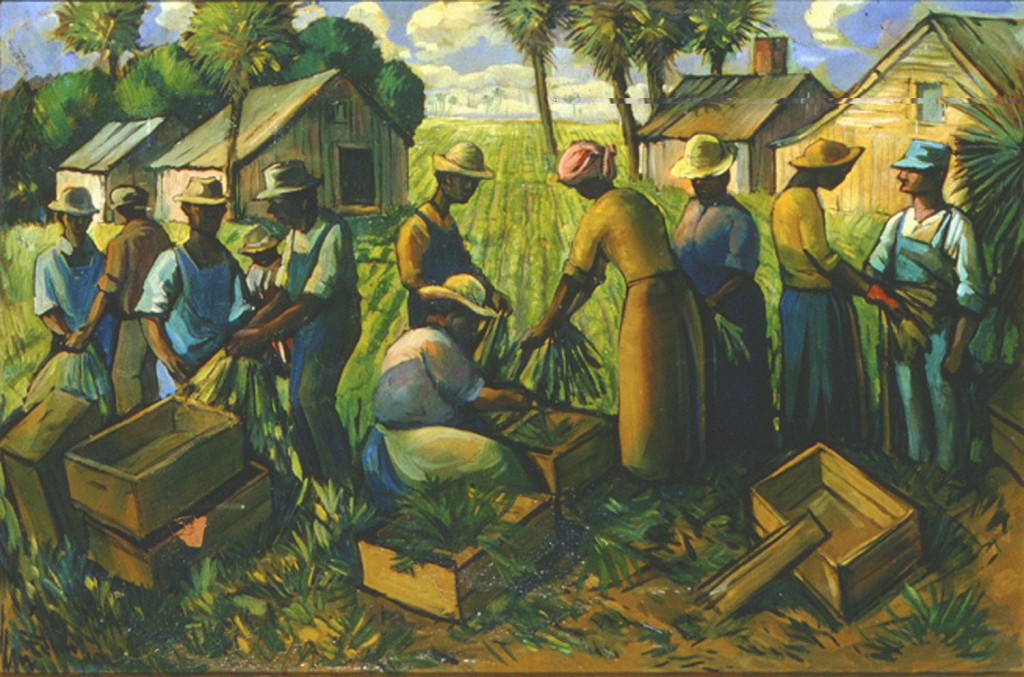
Hurston’s novel embodies the philosophy of visual thinking as the narrator says: “There is a basin in the mind where words float around on thought and thought on sound and sight. Then there is a depth of thought untouched by words, and deeper still a gulf of formless feelings untouched by thought.”
As old Nanny sits rocking Janie in the second chapter, “Mind pictures brought feelings, and feelings dragged out dramas from the hollows of her heart.” Using construction paper, printed images, colored pencils, or whatever other art supplies you choose, you will visually organize the plot, the literary techniques, and the character changes Janie undergoes. By developing this foldable, we can trace the changes in Janie through the four phases of her life.
METHOD:
Begin with a sheet of 11×17 paper. Fold the paper in half, then fold each edge into the center. Crease along the center to form a booklet. While the paper is still folded into a booklet, print the title, and author’s name, and your name on the outside to make a cover. You may decorate this how you choose.
Their Eyes Were Watching God is a frame story, with the beginning and end chapters consisting of Janie’s return to Eatonville and her conversation with Pheoby which frame the flashback segments making up the middle part of the book. Opening the booklet will reveal the opening and closing parts of the frame.
LEFT FLAP: Write about the opening chapter where Janie walks down the street, ignoring the porch sitters as she returns to Eatonville and begins to tell her story to Pheoby. What is your initial impression of Janie? Use illustrations or quotations to explain your perception.
RIGHT FLAP: On the right flap, write about the closing chapter. Janie finishes her conversation with Pheoby, who is amazed by Janie’s transformation. Using illustrations and quotations from Chapter 20, show us how Janie—and your perception of her—has changed.
CENTER SECTIONS: Folding back the flaps will reveal the center, which is creased into four sections. In this novel, Janie journeys through four stages of life in her quest for respect, independence, and wholeness. Each of the four sections of the foldable represents one of those stages. Her life is controlled by others in the first three stages, first her grandmother (Nanny), then Logan Killicks, and Joe (Jody) Starks. After Jody’s death, she is able to make her own decisions leading to her relationship to Tea Cake, and she begins to celebrate her own worth and independence. You will illustrate and explain the stages of her journey, helping you draw conclusions about her character development.
FOR EACH SECTION:
- Give each section a title that expresses what that section is about.
- In each section sketch one visual image (a symbol or icon that you think most expresses an important part of that section; it can be an object, a visual image of an event or place essential to this part of the story) that stands out to you, and use colors that remind you of the mood, setting, or characters. Explain the importance of that symbol or image. EXAMPLE: an axe could symbolize that Logan at first chops wood for Janie, but later they fight over his demands that she chop wood and work in the fields.
- Write about the events in that section, especially the ones that lead to a change in Janie, using quotes from the text. Information in each panel can include where Janie lived, the person who most influenced her life, events of that part of the story, and how Janie changed to meet the challenges of these events and influences. DON’T JUST SUMMARIZE THE STORY. You must use quotes in each section that show stages of Janie’s journey and character development and explain their meaning.
Their Eyes Were Watching God is rich in symbols, imagery, metaphor, and other literary devices. I strongly suggest you complete each section of the project as you finish reading the appropriate chapters. That way, you won’t have to go back and hunt for specifics as you complete each section.
Your project will be graded on its completeness, attention to detail, evidence of thoughtful interpretation, and presentation. This isn’t an art class, so the quality of your art (i.e. hand-drawn vs. pasted images) isn’t the issue, but everyone is expected to submit a neat and professional-looking project.
Untitled painting of Eatonville life, painted c. 1930-40 by Jules Andre Smith, founder of the Research Studio, now known as the Maitland Art Center.
 Now that we have completed reading Shakespeare’s Macbeth, it’s time to update the play for the twenty-first century using one of the two most common social media platforms: Facebook and Twitter.
Now that we have completed reading Shakespeare’s Macbeth, it’s time to update the play for the twenty-first century using one of the two most common social media platforms: Facebook and Twitter.
Their Eyes Were Watching God Foldable
Hurston’s novel embodies the philosophy of visual thinking as the narrator says: “There is a basin in the mind where words float around on thought and thought on sound and sight. Then there is a depth of thought untouched by words, and deeper still a gulf of formless feelings untouched by thought.”
As old Nanny sits rocking Janie in the second chapter, “Mind pictures brought feelings, and feelings dragged out dramas from the hollows of her heart.” Using construction paper, printed images, colored pencils, or whatever other art supplies you choose, you will visually organize the plot, the literary techniques, and the character changes Janie undergoes. By developing this foldable, we can trace the changes in Janie through the four phases of her life.
METHOD:
Begin with a sheet of 11×17 paper. Fold the paper in half, then fold each edge into the center. Crease along the center to form a booklet. While the paper is still folded into a booklet, print the title, and author’s name, and your name on the outside to make a cover. You may decorate this how you choose.
Their Eyes Were Watching God is a frame story, with the beginning and end chapters consisting of Janie’s return to Eatonville and her conversation with Pheoby which frame the flashback segments making up the middle part of the book. Opening the booklet will reveal the opening and closing parts of the frame.
LEFT FLAP: Write about the opening chapter where Janie walks down the street, ignoring the porch sitters as she returns to Eatonville and begins to tell her story to Pheoby. What is your initial impression of Janie? Use illustrations or quotations to explain your perception.
RIGHT FLAP: On the right flap, write about the closing chapter. Janie finishes her conversation with Pheoby, who is amazed by Janie’s transformation. Using illustrations and quotations from Chapter 20, show us how Janie—and your perception of her—has changed.
CENTER SECTIONS: Folding back the flaps will reveal the center, which is creased into four sections. In this novel, Janie journeys through four stages of life in her quest for respect, independence, and wholeness. Each of the four sections of the foldable represents one of those stages. Her life is controlled by others in the first three stages, first her grandmother (Nanny), then Logan Killicks, and Joe (Jody) Starks. After Jody’s death, she is able to make her own decisions leading to her relationship to Tea Cake, and she begins to celebrate her own worth and independence. You will illustrate and explain the stages of her journey, helping you draw conclusions about her character development.
FOR EACH SECTION:
Their Eyes Were Watching God is rich in symbols, imagery, metaphor, and other literary devices. I strongly suggest you complete each section of the project as you finish reading the appropriate chapters. That way, you won’t have to go back and hunt for specifics as you complete each section.
Your project will be graded on its completeness, attention to detail, evidence of thoughtful interpretation, and presentation. This isn’t an art class, so the quality of your art (i.e. hand-drawn vs. pasted images) isn’t the issue, but everyone is expected to submit a neat and professional-looking project.
Untitled painting of Eatonville life, painted c. 1930-40 by Jules Andre Smith, founder of the Research Studio, now known as the Maitland Art Center.
Comments Off on Their Eyes Were Watching God Foldable
Filed under AP Literature
Tagged as analysis, AP, commentary, creativity, Their Eyes Were Watching God